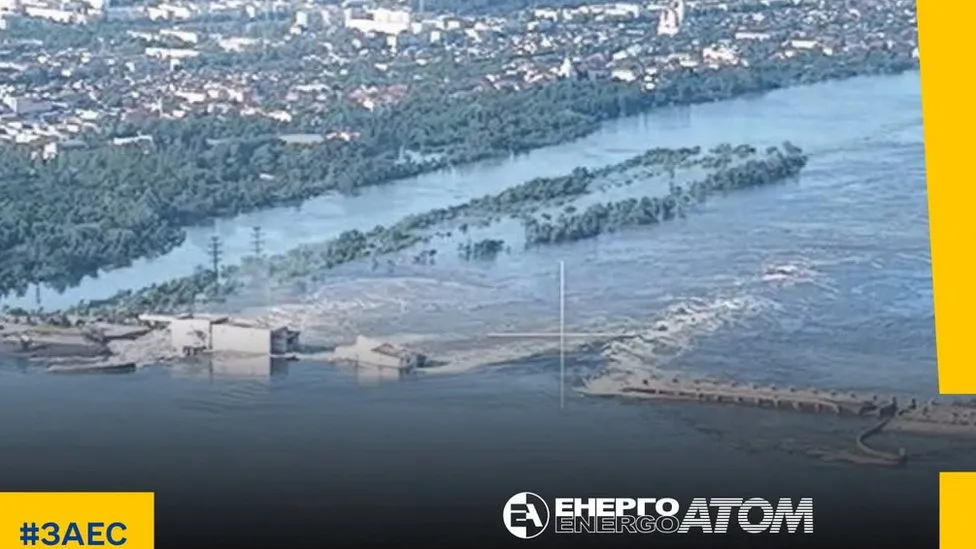What we know about Nova Kakhovka dam attack
A huge dam in the Russian-controlled area of southern Ukraine has been destroyed, unleashing a flood of water.

Ukraine's military and Nato have accused Russia of blowing up the dam, while Russia has blamed Ukraine.
Thousands of people are being evacuated from communities in the surrounding areas, with fears that any flooding could be catastrophic.
Here's what we know so far.
Where is the dam?
The Kakhovka Hydroelectric Power Plant is in the city of Nova Kakhovka in Ukraine's Kherson region, which is currently under Russian occupation.
It was built in the Soviet era and is one of six dams that sit along the Dnipro river, which stretches all the way from the very north of the country into the sea in the south.
It's huge - locals call it the Kakhovka Sea as you cannot see the other bank in certain places. The dam holds water equal to the Great Salt Lake in the US state of Utah, according to Reuters.
What happened?
Stills and video show a massive breach in the dam, with water surging through it and flooding downstream in the direction of Kherson.
It's unclear when exactly the dam was first damaged, but satellite images verified by the BBC suggest its condition has deteriorated over a number of days.
A road across the dam appears to be damaged from 2 June, but there does not seem to be a change to the flow of the water until 6 June when the breach of the wall and collapse of nearby buildings can be clearly seen on video. It is currently unclear whether the damage to the road is linked to the 6 June breach.
A map shows damage to a bridge crossing the Kakhovka in early June, then a breach of the bridge on 6 June
While it is unclear how extensive the flooding downstream will be, there are fears it could be devastating for settlements in a critical zone, home to around 16,000 people.
Images from Nova Kakhova show buildings surrounded by floodwaters and even swans paddling around a local government office.
The authorities in Kherson, less than 50 miles downstream, have warned residents in low lying parts of the city to evacuate as quickly as possible and seek shelter on higher ground.
The head of the Kherson region, Oleksandr Prokudin, told Ukrainian TV this morning that eight villages had been fully or completely flooded already, with more expected to be flooded.
Ukrainian hydro power dam operator UkrHydroEnerho said the station was "fully destroyed" and could not be restored.
Why has it been attacked?
It's not yet clear what caused the breach in the dam, but Ukraine's military has accused Russia of deliberately blowing it up. This seems plausible, as Moscow may have feared that Ukrainian forces would use the road over the dam to get troops across the river into Russian-held territory, as part of a counter-offensive.
Russian-installed officials have blamed Ukraine for striking the dam, but they say only the plant's upper part was destroyed by shelling - not the dam itself.
Neither Ukraine or Russia's claims have been verified by the BBC.
The dam is very important and serves a number of purposes.
It holds back a vast reservoir that supplies water for a host of communities upstream. Farmers upstream of Kakhovka rely on the water to grow their crops, so this could impact tens of thousands of people if it recedes far enough and causes issues with irrigation for farmers and local residents.
The dam also provides cooling water to the nuclear power station at Zaporizhzhia, around 100 miles upstream, which is under Russian control and relies on the reservoir.
The International Atomic Energy Agency (IAEA) said there was no immediate nuclear safety risk but it was monitoring the situation.
It later said in a statement that if the dam did fall below 12.7m, the lowest level at which water can still be pumped upstream to Zaporizhzhia, there were alternative water sources to keep the nuclear plant cool, including a large cooling pond next to the site.
A map shows the Zaporizhzhia power plant and the Kakhova dam in Ukraine
But as well as that, the dam is a vital channel carrying water from the Dnipro to Russian-occupied Crimea, meaning water supplies there are likely to be affected.
After Russia annexed Crimea in 2014, Ukraine blocked a channel carrying water from Nova Kakhovka, triggering a water crisis on the peninsula.
Russian forces reopened the channel soon after last year's full-scale invasion. But without the dam, dropping water levels could once again jeopardise the flow of water along the channel.
Russia has previously carried out several attacks on dams throughout Ukraine since the invasion, causing widespread flooding and disrupting power supplies.
-bbc







